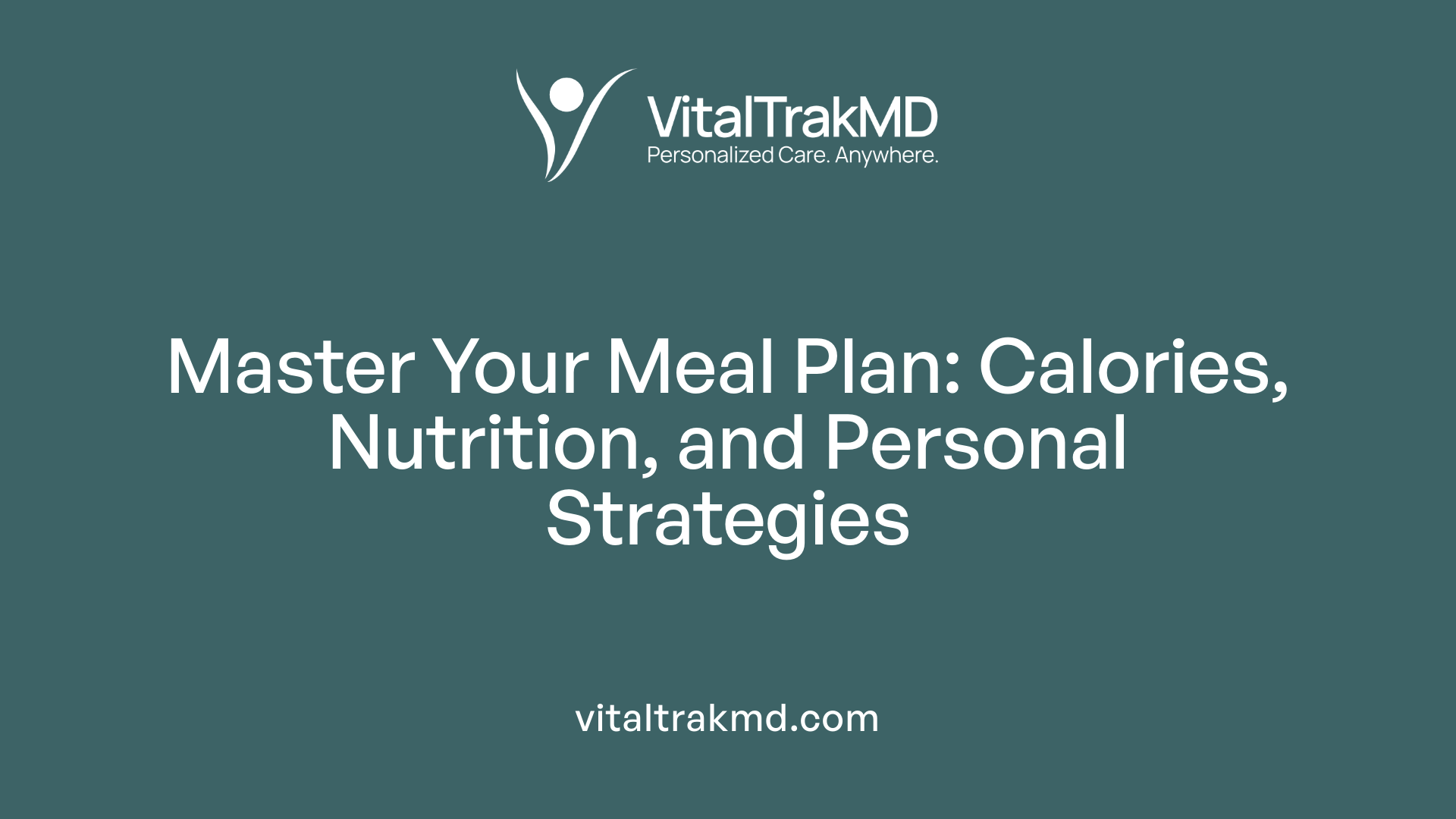How to Build a Personalized Weight Loss Plan with VitalTrak

Embarking on a Personalized Weight Loss Journey
Creating an effective, personalized weight loss plan requires a comprehensive understanding of your unique needs, preferences, and health status. With advancements in digital health tools like VitalTrak, along with expert-guided programs, developing a tailored strategy has become more accessible and precise. This article explores how to leverage technology, professional support, and evidence-based methods to craft a sustainable weight management plan that aligns with your individual goals.
Fundamentals of Personalizing Your Weight Loss Plan

How can I create a personalized weight loss plan?
Creating an effective and tailored weight loss plan starts with understanding your unique health profile. Begin by assessing your current medical history, dietary preferences, activity levels, and specific goals.
One helpful approach is to use tools like the MyPlate Plan calculator, which helps determine your daily calorie needs based on your age, sex, and activity level. This foundational data guides the development of a sustainable plan.
Incorporating principles from the Mayo Clinic Diet can enhance your plan's effectiveness. This diet emphasizes long-term health habits, includes flexible meal options, and encourages eating whole, nutrient-dense foods.
Utilize digital tools such as food diaries, exercise trackers, and calorie counting apps to monitor your consumption and activity. These tools support accountability and help identify areas needing adjustment.
Prioritize making gradual, sustainable changes. Planning weekly menus, allowing occasional treats, and setting realistic goals contribute to better adherence.
Regular self-monitoring through weigh-ins and dietary logs ensures you stay on track. Always consult healthcare professionals before making significant changes, especially if you have existing health conditions or are on medications.
Remember, the goal is steady, long-lasting progress through a combination of healthy eating and regular physical activity, focusing on lifestyle modifications rather than quick fixes.
What resources and tools can help personalize my weight loss plan?
Various resources and digital tools can significantly enhance the personalization of your weight management journey. The Mayo Clinic Diet provides scientifically based, flexible programs customized to your health history and lifestyle.
Calorie calculators and meal planning apps like MyPlate facilitate the creation of personalized daily menus that align with your nutritional needs.
Fitness trackers and activity monitors help you set goals, track your physical activity, and motivate continuous progress.
Healthcare provider guidance, especially regarding potential use of prescription medications such as GLP-1 receptor agonists like Wegovy®, is essential for tailored treatment. These professionals can oversee your health status, recommend appropriate interventions, and monitor your progress.
Government resources like the CDC's MyPlate Plan or interactive quizzes support nutrition customization based on personal data such as age, sex, and activity levels.
For a comprehensive approach, programs like Livea offer personalized plans with behavioral coaching and medical supervision, integrating digital tools with professional support.
Using these resources collectively ensures your weight loss strategy is well-suited to your needs, increasing the chances of sustained success.
Implementing a Step-by-Step Strategy for Long-Term Success

Is there a step-by-step guide for developing a tailored weight management strategy?
Yes, crafting a personalized weight management plan involves a clear, sequential process. It begins with understanding your personal motivations—your "why"—which helps sustain commitment during challenging times. This could include improving health, increasing energy levels, or enhancing quality of life.
Next, assess your current habits across several areas: nutrition, physical activity, sleep, and stress levels. Recognizing patterns in these areas helps identify specific changes needed. Setting small, achievable goals, like walking for 15 minutes a few times a week, makes the process feel manageable.
Planning your diet is crucial. Focus on calorie control, reading nutrition labels, and preparing balanced meals rich in nutrients. Incorporate enjoyable physical activities into your routine, aiming for at least 150 minutes of moderate exercise weekly or 75 minutes of vigorous activity.
Regular monitoring is vital. Track your weight, habits, and feelings of well-being. Make adjustments based on progress, staying flexible to adapt your plan as needed. Maintaining behavioral changes—such as consistent healthy eating and regular activity—is essential for enduring results.
Lastly, seek support from friends, family, or healthcare professionals who can provide encouragement and accountability throughout your journey.
How does the use of tools like VitalTrak facilitate goal setting and progress tracking?
Tools like VitalTrak enhance weight management by providing real-time data on various health metrics, including heart rate, calorie burn, and sleep quality. They connect seamlessly with mobile apps, enabling users to log food intake, monitor macro and micronutrients, and track physical activity.
The detailed analytics offered by VitalTrak help users set realistic, measurable goals and see progress toward them. This transparency encourages accountability and motivates continued effort.
Healthcare providers can access the data, allowing them to offer personalized advice tailored to an individual’s progress and challenges. These insights enable precise adjustments to diet and exercise plans, increasing the likelihood of success.
Consistent use of tracking tools fosters behavioral habits—such as mindful eating and increased activity—that are important for sustainable weight loss. By continuously measuring and evaluating progress, users can stay motivated and make informed decisions, leading to more effective and lasting results.
| Step Stage | Activities | Tools & Support | Focus Area |
|---|---|---|---|
| Goal Setting | Define motivation, set small goals | Personal reflection, planning | Motivation & habits |
| Habit Assessment | Analyze current eating, activity, sleep | Self-monitoring, apps | Behavior analysis |
| Implementation | Develop diet plan, schedule exercise | Nutrition guides, activity trackers | Nutrition & physical activity |
| Monitoring & Adjustment | Track progress, modify plan | VitalTrak, regular weigh-ins | Progress tracking & flexibility |
| Support & Accountability | Engage community & professionals | Support groups, healthcare visits | Emotional & professional support |
This structured approach, augmented with advanced tools like VitalTrak, empowers individuals to build sustainable weight management routines centered on informed choices and ongoing support.
Dietary Strategies, Calorie Calculation, and Meal Planning Essentials

How should dietary strategies, calorie calculations, and meal planning be incorporated into a personalized weight loss plan?
Creating an effective personal weight loss plan begins with understanding individual needs, which include medical history, lifestyle, and dietary preferences. A crucial step is estimating your daily calorie needs, which can be calculated using formulas such as the Mifflin-St. Jeor equation. This takes into account your age, sex, height, weight, and activity level.
Once your baseline calorie needs are determined, establishing a calorie deficit is essential for weight loss. Typically, a reduction of 500 to 750 calories per day is recommended, either through dietary modifications, increased physical activity, or a combination of both. This deficit generally leads to a safe weight loss rate of about 1-2 pounds per week.
Designing a meal plan around nutrient-dense foods helps ensure nutritional adequacy. Prioritize fruits, vegetables, lean proteins, whole grains, and healthy fats. Avoid ultra-processed foods and refined carbs, which can hinder weight loss and impact overall health.
Incorporating structured meal timing and replacements can improve adherence and metabolic health. For example, larger, balanced breakfasts and maintaining periods of overnight fasting—such as in intermittent fasting—may support better calorie control.
To match personal health goals, adjust macronutrient ratios—carbohydrates, proteins, and fats—based on preferences and medical conditions. Monitoring progress regularly is vital. If weight loss plateaus, recalibrating calorie intake and activity levels can sustain momentum.
With modern tools, platforms like VitalTrak facilitate this process by providing real-time food logging, macro tracking, and personalized feedback. These digital solutions help users maintain their calorie deficits, plan nutritious meals, and stay motivated throughout their weight management journey.
In summary, integrating precise calorie calculations, personalized meal planning, and behavior modification strategies creates a sustainable, health-focused approach for effective weight loss.
Developing an Effective Weight Loss Plan Using VitalTrak and Similar Tools

How does one craft a weight loss plan using tools like VitalTrak or similar methods?
Creating a personalized weight management strategy involves more than just wishful thinking; it requires thoughtful planning supported by reliable tools such as VitalTrak. To start, set SMART goals—these are specific, measurable, attainable, relevant, and time-bound targets that give your weight loss journey clear direction.
Using tracking features available in VitalTrak or comparable devices, you can monitor your daily food intake, physical activity, and overall progress. This detailed data helps identify habits, patterns, and areas needing adjustment, making your approach more precise.
A crucial aspect of effective weight management is maintaining a balanced caloric intake aligned with your activity level. Focus on consuming nutrient-dense foods like vegetables, fruits, lean proteins, and whole grains. Reducing intake of sugary drinks, processed snacks, and refined foods supports better results.
Physical activity plays a vital role. Aim for at least 150 minutes of moderate activity, such as brisk walking or cycling, or 75 minutes of vigorous activity weekly. Incorporate strength training exercises a couple of times each week to boost muscle mass and elevate metabolism.
Supporting your efforts involves ensuring adequate sleep, managing stress, and fostering sustainable habits. This holistic approach encourages long-term success instead of quick fixes.
Many people leverage these tools to adjust their plans as they learn what works best for their bodies. Regular updates and reflections based on tracked data help in fine-tuning your regimen, making your weight loss strategy adaptable and realistic.
In addition to using these digital tools, consulting healthcare professionals can tailor your plan further, especially if you consider supplements or medications. Combining medical guidance with technology-supported tracking offers a comprehensive, sustainable path to achieving health goals.
Achieving Long-Term Success with Customized Strategies
Building a personalized weight loss plan with tools like VitalTrak involves a holistic approach that combines technological monitoring, professional guidance, evidence-based dietary strategies, and sustainable behavior changes. By assessing individual needs, setting clear goals, utilizing digital tools for tracking, and engaging healthcare providers, you can develop a tailored plan that promotes safe and effective weight loss. Emphasizing long-term lifestyle modifications ensures that these successes are maintained, ultimately supporting your journey toward improved health and wellness.
References
- How to Create a Personalized Weight Management Plan
- Weight Loss Programs in Chattanooga, TN
- Weight loss
- Free Personalized Diet Plan
- MyPlate Plan Calculator
- Make a plan for weight-loss success
- The 7 Components of a Successful Weight Loss Plan
- How to Create a Nutrition Plan
- Vital Fit Track: Official Website
- VitalTrack Health - Apps on Google Play
Recent articles
Want to Feel Better and Live Healthier?
Join hundreds of patients taking control of their health with personalized care that fits their life – not the other way around.
Rated 4.8/5 by 32+ customers







